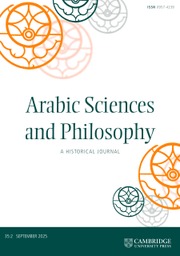No CrossRef data available.
Article contents
USE OF THE GALAXY AS A TOOL FOR SPATIAL AND TEMPORAL ORIENTATION DURING THE EARLY ISLAMIC PERIOD AND UP TO THE 15TH CENTURY
Published online by Cambridge University Press: 03 March 2021
Abstract
We study to what extent the Milky Way was used as an orientation tool at the beginning of the Islamic period covering the 8th to the 15th century, with a focus on the first half of that era. We compare the texts of three authors from three different periods and give detailed comments on their astronomical and traditional content. The text of al-Marzūqī summarises the information on the Milky Way put forward by the astronomer and geographer ʾAbū Ḥanīfa al-Dīnawarī. The text makes it clear that in some areas the Milky Way could be used as a geographical guide to determine the approximate direction toward a region on Earth or the direction of prayer. In the 15th century, the famous navigator Aḥmad b. Māǧid describes the Milky Way in his nautical instructions. He frequently demonstrates that the Milky Way serves as a guidance aid to find constellations and stars that are useful for precise navigation on land and at sea. On the other hand, Ibn Qutayba quotes in his description of the Milky Way a saying from the famous Bedouin poet Ḏū al-Rumma, which is also mentioned by al-Marzūqī. In this saying the Milky Way is used to indicate the hot summer times in which travelling the desert was particularly difficult. Hence, the Milky Way was useful for orientation in space and time and was used for agricultural and navigational purposes.
Résumé
Nous étudions dans quelle mesure la Voie lactée a été utilisée comme outil d'orientation au début de la période islamique couvrant du 8e au 15e siècle, avec un accent sur la première moitié de cette période. Nous comparons les textes de trois auteurs au cours de trois périodes différentes et donnons des commentaires détaillés sur leur contenu astronomique et traditionnel. Le texte d'al-Marzūqī résume les informations sur la Voie lactée proposées par l'astronome et géographe ʾAbū Ḥanīfa al-Dīnawarī. Le texte indique clairement que dans certaines régions, la Voie lactée pourrait être utilisée comme guide géographique pour déterminer la direction approximative vers une région terrestre ou la direction de la prière. Au 15e siècle, le célèbre navigateur Aḥmad b. Māǧid décrit la Voie lactée dans ses instructions nautiques. Il démontre fréquemment que la Voie lactée sert de guide pour trouver des constellations et des étoiles utiles pour une navigation précise sur terre et sur mer. D'autre part, dans sa description de la Voie lactée, Ibn Qutayba cite un vers du poète Ḏū al-Rumma également mentionné par al-Marzūqī. La Voie lactée y est utilisée pour indiquer les heures chaudes de l’été durant lesquelles voyager dans le désert était particulièrement difficile. Par conséquent, la Voie lactée était utile pour l'orientation dans l'espace et le temps et a été utilisée pour l'agriculture et à des fins de navigation.
- Type
- Research Article
- Information
- Copyright
- Copyright © The Author(s), 2021. Published by Cambridge University Press


